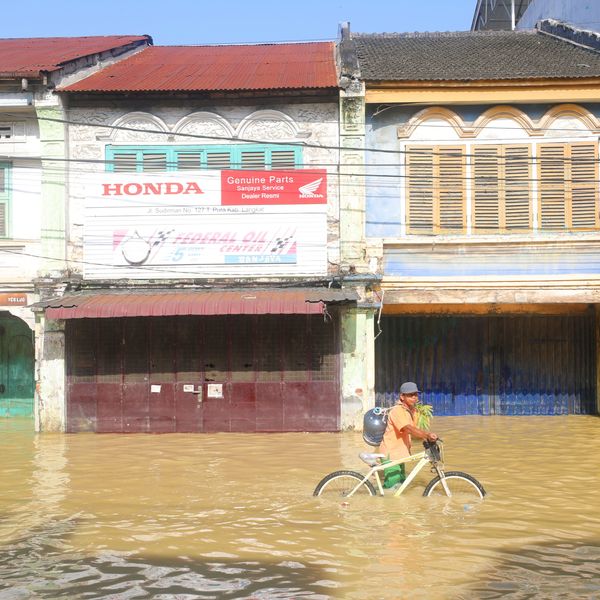The Floating Catastrophe
Our nation's waterways are at risk to become the new highways for dangerous fracking waste. The U.S. Coast Guard has proposed the opening of the Ohio River, and other major waterways, as a route for shale gas extraction wastewater. If approved, the fracking waste barges pose a hazard to all those who drink and live near these waterways.
Our nation's waterways are at risk to become the new highways for dangerous fracking waste. The U.S. Coast Guard has proposed the opening of the Ohio River, and other major waterways, as a route for shale gas extraction wastewater. If approved, the fracking waste barges pose a hazard to all those who drink and live near these waterways.
GreenHunter Resources, Inc. is seeking permission to build a barge dock that could accommodate roughly 105,000,000 gallons of fracking waste at once. A facility of this size could endanger contiguous ecosystems and communities. Almost 686 million gallons of fracking wastewater was dumped in Ohio last year alone, in which half came from out of state sites. If approved, the new proposals could eventually transform Ohio into a fracking wasteland.
Proponents argue that barging the waste is a safer alternative to transporting it by truck or railway. However, the quantity of chemical waste could wreak havoc on communities nearby and downstream for months, even years, if there were a mishap.
Due to recent gas-related accidents, residents and local water officials resent the proposal. Earlier this year, President Obama and West Virginia Governor Earl Ray Tomblin declared a state of emergency after harmful chemicals poured into the Elk River. The warning came too late for many West Virginia residents, as hundreds of people who drank or used the water reported symptoms such as vomiting, rashes and dizziness.
Millions of people could face serious health problems if an accident of this magnitude occurred on the Ohio River. The river and its watershed stretch 981 miles and it flows through six states, coming into contact with many fragile ecosystems. The river is the source of drinking water for over three million people, and 10 percent of the U.S. population lives in the Ohio River Basin.
As seen with other massive chemical spills, they are hard to contain, and even harder to clean up in many cases. Enacted by Vice President Dick Cheney in 2005, the Halliburton Loophole allows oil companies to keep secret the chemicals they use in their hydraulic fracturing process. Each company's chemical cocktail differs, leaving workers flying blind when clearing up spills and assessing damage.
The risk of contaminating such a large water source is incredibly irresponsible, as the slightest accident could be calamitous. Ultimately, the proposal is just another example of the grip oil and gas companies have on our government.
The time for action is now. Send public comments through July 28, 2014 to urge the Coast Guard to deny fracking wastewater transport on our nation's greatest waterways.
An Urgent Message From Our Co-Founder
Dear Common Dreams reader, The U.S. is on a fast track to authoritarianism like nothing I've ever seen. Meanwhile, corporate news outlets are utterly capitulating to Trump, twisting their coverage to avoid drawing his ire while lining up to stuff cash in his pockets. That's why I believe that Common Dreams is doing the best and most consequential reporting that we've ever done. Our small but mighty team is a progressive reporting powerhouse, covering the news every day that the corporate media never will. Our mission has always been simple: To inform. To inspire. And to ignite change for the common good. Now here's the key piece that I want all our readers to understand: None of this would be possible without your financial support. That's not just some fundraising cliche. It's the absolute and literal truth. We don't accept corporate advertising and never will. We don't have a paywall because we don't think people should be blocked from critical news based on their ability to pay. Everything we do is funded by the donations of readers like you. Will you donate now to help power the nonprofit, independent reporting of Common Dreams? Thank you for being a vital member of our community. Together, we can keep independent journalism alive when it’s needed most. - Craig Brown, Co-founder |
Our nation's waterways are at risk to become the new highways for dangerous fracking waste. The U.S. Coast Guard has proposed the opening of the Ohio River, and other major waterways, as a route for shale gas extraction wastewater. If approved, the fracking waste barges pose a hazard to all those who drink and live near these waterways.
GreenHunter Resources, Inc. is seeking permission to build a barge dock that could accommodate roughly 105,000,000 gallons of fracking waste at once. A facility of this size could endanger contiguous ecosystems and communities. Almost 686 million gallons of fracking wastewater was dumped in Ohio last year alone, in which half came from out of state sites. If approved, the new proposals could eventually transform Ohio into a fracking wasteland.
Proponents argue that barging the waste is a safer alternative to transporting it by truck or railway. However, the quantity of chemical waste could wreak havoc on communities nearby and downstream for months, even years, if there were a mishap.
Due to recent gas-related accidents, residents and local water officials resent the proposal. Earlier this year, President Obama and West Virginia Governor Earl Ray Tomblin declared a state of emergency after harmful chemicals poured into the Elk River. The warning came too late for many West Virginia residents, as hundreds of people who drank or used the water reported symptoms such as vomiting, rashes and dizziness.
Millions of people could face serious health problems if an accident of this magnitude occurred on the Ohio River. The river and its watershed stretch 981 miles and it flows through six states, coming into contact with many fragile ecosystems. The river is the source of drinking water for over three million people, and 10 percent of the U.S. population lives in the Ohio River Basin.
As seen with other massive chemical spills, they are hard to contain, and even harder to clean up in many cases. Enacted by Vice President Dick Cheney in 2005, the Halliburton Loophole allows oil companies to keep secret the chemicals they use in their hydraulic fracturing process. Each company's chemical cocktail differs, leaving workers flying blind when clearing up spills and assessing damage.
The risk of contaminating such a large water source is incredibly irresponsible, as the slightest accident could be calamitous. Ultimately, the proposal is just another example of the grip oil and gas companies have on our government.
The time for action is now. Send public comments through July 28, 2014 to urge the Coast Guard to deny fracking wastewater transport on our nation's greatest waterways.
Our nation's waterways are at risk to become the new highways for dangerous fracking waste. The U.S. Coast Guard has proposed the opening of the Ohio River, and other major waterways, as a route for shale gas extraction wastewater. If approved, the fracking waste barges pose a hazard to all those who drink and live near these waterways.
GreenHunter Resources, Inc. is seeking permission to build a barge dock that could accommodate roughly 105,000,000 gallons of fracking waste at once. A facility of this size could endanger contiguous ecosystems and communities. Almost 686 million gallons of fracking wastewater was dumped in Ohio last year alone, in which half came from out of state sites. If approved, the new proposals could eventually transform Ohio into a fracking wasteland.
Proponents argue that barging the waste is a safer alternative to transporting it by truck or railway. However, the quantity of chemical waste could wreak havoc on communities nearby and downstream for months, even years, if there were a mishap.
Due to recent gas-related accidents, residents and local water officials resent the proposal. Earlier this year, President Obama and West Virginia Governor Earl Ray Tomblin declared a state of emergency after harmful chemicals poured into the Elk River. The warning came too late for many West Virginia residents, as hundreds of people who drank or used the water reported symptoms such as vomiting, rashes and dizziness.
Millions of people could face serious health problems if an accident of this magnitude occurred on the Ohio River. The river and its watershed stretch 981 miles and it flows through six states, coming into contact with many fragile ecosystems. The river is the source of drinking water for over three million people, and 10 percent of the U.S. population lives in the Ohio River Basin.
As seen with other massive chemical spills, they are hard to contain, and even harder to clean up in many cases. Enacted by Vice President Dick Cheney in 2005, the Halliburton Loophole allows oil companies to keep secret the chemicals they use in their hydraulic fracturing process. Each company's chemical cocktail differs, leaving workers flying blind when clearing up spills and assessing damage.
The risk of contaminating such a large water source is incredibly irresponsible, as the slightest accident could be calamitous. Ultimately, the proposal is just another example of the grip oil and gas companies have on our government.
The time for action is now. Send public comments through July 28, 2014 to urge the Coast Guard to deny fracking wastewater transport on our nation's greatest waterways.

